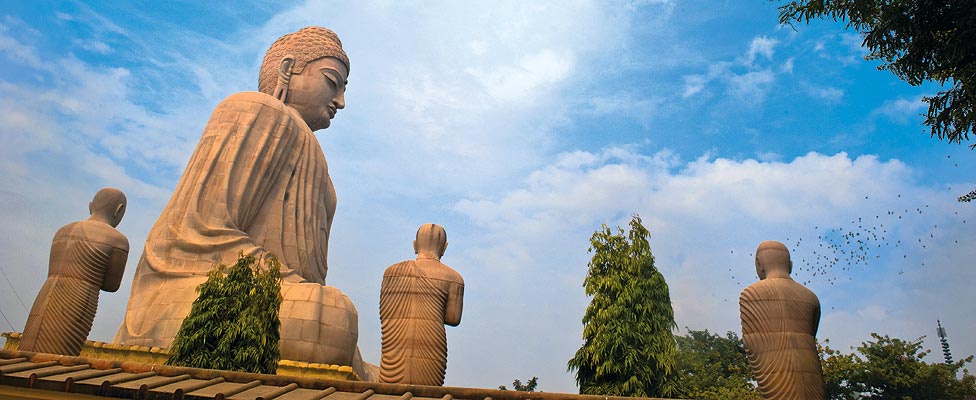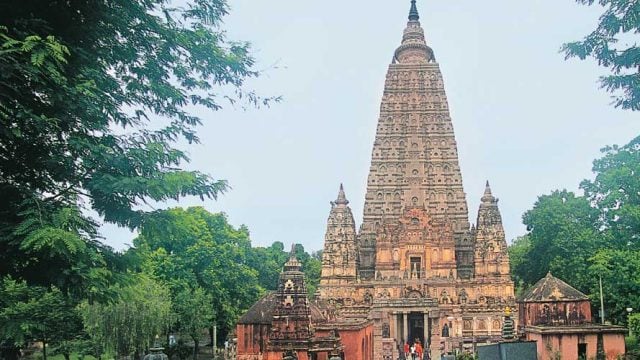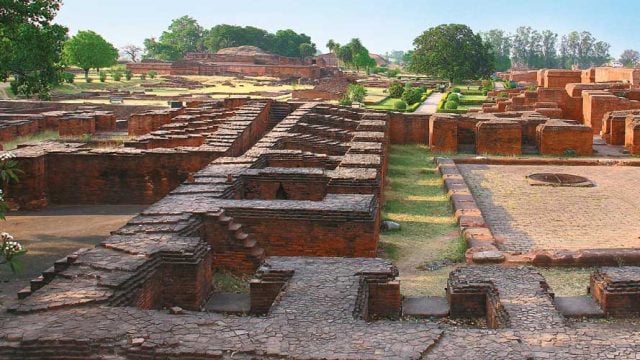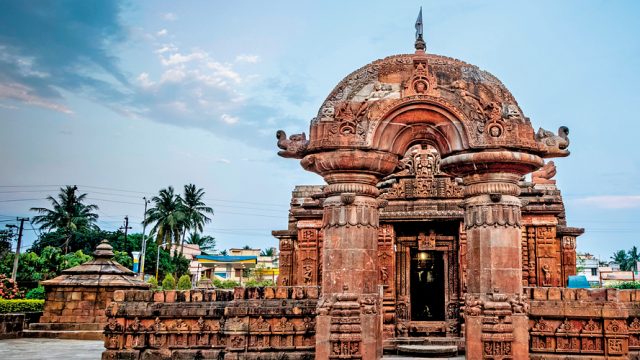A ceaseless, polylingual chatter and the clickety-clack of Buddhist prayer beads enveloped me as Air India’s short-haul

Photo credit: Sandipan Chatterjee
And yet, the snatches of overheard babble also served as audible affirmation of the continuing expansion of the Buddhist footprint into newer and unlikely geographies. Ekaterina, seated to my right, was a Russian émigré from Siberia who now lives in Alaska, and was travelling to Bodh Gaya for the Kagyu Monlam festival in mid-December, at which practitioners of various schools of Tibetan Buddhism gather to pray. Ximena, to my left, was from Chile: she embraced Buddhism after a 2006 visit by the Dalai Lama to her country. Also on the plane were travellers from Greenland, Mexico and Costa Rica, in addition to more familiar (and more proximate) centres of Buddhist worship: Thailand, Hong Kong and Vietnam.
Buddhism may have been considered the ‘Light of Asia’, as the 19th-century poet Edwin Arnold described it in his immortal poem of the same name, but today its illumination spreads farther afield to rather more remote corners of the wide world. And believers from all over are flocking in ever larger numbers to the Ground Zero of their belief system, the town where the tree of wisdom took root and spread out.
More evidence of Bodh Gaya’s international profile can be had at the Mahabodhi temple, the world heritage site that is the pre-eminent place of pilgrimage for Buddhists. At any time, groups of worshippers — monks and laity, many in their distinctive national garb and accessories (and others in less austere Mickey Mouse leggings!) — can be seen chanting or meditating, or perambulating the temple complex, which was built around the Bodhi tree. Other monks and devotees perform countless prostrations to the revered tree. It is a highly rigorous purificatory ritual, and some are known to do up to a hundred thousand prostrations at a time.

Photo credit: Sandipan Chatterjee
The temple complex today stands beautifully refurbished, and on winter nights such as these, when the lights come on, the temple tower, believed to have been built in the 3rd century BCE by Mauryan emperor Ashoka, stands tall like a beacon of Buddhism that can seen from miles away. After last year’s serial bomb blasts at the temple complex, a semblance of heightened security is manifest, but the stipulation disallowing mobile phones appears to be honoured more in the breach. Indeed, ubiquitous cellphones and tablets with cameras — which even some monks in ascetic robes wield like dharmachakras — are something of a rude intrusion on the solemnity of worship.

Photo credit: Sandipan Chatterjee
The principal points of interest in the temple complex are the Bodhi tree; the Vajrasana, the Diamond Throne or the Seat of Stability, a red sandstone platform at the spot where the Buddha meditated; the Mahabodhi temple, the towering ornate structure to the east of the Bodhi tree, which houses a large, gilded, blackstone image of the Buddha in the bhumisparsamudra (earth-touching posture); the carved, sculpted stone railing around the temple, believed to have been built around the 1st century BCE; and votive stupas and structures that commemorate events during the seven weeks that the Buddha spent here in a state of bliss after his Enlightenment, before he set out for Sarnath to proclaim to the world the liberating truths he had realised.
The Bodhi tree that is at the centre of the Buddhist universe is at the western end of the temple complex. To the knots of faithful who come to chant or meditate beneath it, this arboreal sprawl symbolises the potential for each human being to realise ‘the Buddha within’ by living a life of moderation.

Photo credit: Sandipan Chatterjee
My own yearnings of the moment, however, were far less noble and rather more immoderately acquisitive. I had been expressly commissioned by family members to secure a leaf from the tree, and in the mistaken belief that they would be available for the picking, I had made rash and plentiful promises. But now as I paced the tree’s periphery, alert for fallen leaves, a curious sense of wonderment came over me. There wasn’t even a single one on that vast expanse of ground, an oddity that I couldn’t account for, even budgeting for the frequent and very diligent exertions of the broom-wielding sweepers.
Just then, a cool winter breeze blew across the courtyard, causing the Bodhi tree’s branches to swoop and sway tantalisingly, but again not a single leaf unhinged itself. I suddenly became aware that I wasn’t the only bounty-hunter. Other seekers of arboreal mementoes were scouring the ground, and the chances of my securing one, even should it fall, were diminishing. Acknowledging the odds, I headed for the exit, but my attention was drawn to a monk who sidled up to me and flashed a leaf from within the folds of his robes. “Only 50 rupees,” he said. But something in me — perhaps my inner Buddha — bristled at the idea of consummating so crass a commercial transaction beneath that very tree. I sidestepped him and headed out.
Beyond the temple complex, Bodh Gaya is a bit of a one-horse town, so Sandipan and I hailed a horse-drawn tonga for a quick roundabout of other places associated with the Buddha’s life. About three kilometres to the west of Bodh Gaya flowed the erstwhile Nilanjana, now called Phalgu (and utterly bone-dry). A short walk away is a small shrine dedicated to Sujata, the Uruvela tribeswoman who offered kheer to the starving Siddhartha before he became the Buddha. The idol there depicts a skin-and-bones Siddhartha, his skull a virtual death’s head, accepting Sujata’s offering. It’s a folksy, unostentatious shrine that makes for a pleasant diversion.
Other than that, Bodh Gaya is home to many monasteries and temples and Buddhist icons, the most majestic of which is the 80-foot alfresco statue of the Buddha in the gyanamudra posture, built with Japanese funds in 1989. And the Tibetan markets that come up around the temple complex unfailingly draw visitors hunting for curios.
In a sense, you could ‘do’ Bodh Gaya in a day, and believe you’ve seen it all. But given the many-layered intensity of Buddhist teachings, you could stay a whole lifetime and still feel you’ve not experienced it fully. Many Western travellers spend weeks, even months, practising meditation techniques or enrolling for introductory courses in Buddhist teachings or learning to read Pali, the language of the commoners and of the Buddha. Others who came on a spiritual quest, much like Siddhartha himself did, are ‘living the practice’ and are taking forward the core Buddhist teaching of compassion and wisdom in their own way.
One such practitioner, Michael Saatkamp, a social worker from Germany, was drawn to Bodh Gaya after years of travels in Asia, and, upon arriving, had an epiphanic calling. He first set up a soup kitchen called A Bowl of Compassion, with funds raised from donors in Germany, but has over the years expanded to establish a primary school for indigent village children, where the kids get (in addition to a functional academic grounding) hot meals, free footwear — and lessons in mindful living and compassion.
It’s just one of the many ways in which the Buddha’s teachings live on in the town from where the Buddhist beacon shines forth to the world…
The information
Getting there: The nearest airport and railhead isGaya, about 20km away. Air India operates services to Gaya from Delhi, Kolkata and Varanasi; from Delhi, round-trip fares are about Rs 14,000. Gaya is well-connected by rail with Delhi and Kolkata; one-way train fares from Delhi vary from Rs 490 (sleeper class) to Rs 1,630 (3AC) to Rs 3,740 (1AC). From Gaya, you could hire a taxi / autorickshaw for Rs 300 / 200; or you could flag a shared auto for Rs 30.
Where to stay: Like the accommodative religious order that was born here, Bodh Gaya has room for all comers — princes as well as plebeians. Accommodation is plentiful across all budget ranges.
I stayed at Charity Backpackers, a basic but comfortable option run by Michael Saatkamp, a German social worker, in Tika Bigha village, barely a 10-min walk from the Mahabodhi temple. It has a 10-bed dormitory (Rs 100 per bed per night); single rooms (Rs 200-250); and double rooms (Rs 250-500). Meals cost Rs 50-100 per day. Michael also runs A Bowl of Compassion, a soup-kitchen and primary school for indigent children, and volunteering your time and interacting with the kids makes for a joyful experience (+91-9122545831,[email protected],bowlofcompassion.org).

Photo credit: Sandipan Chatterjee
More upscale options include Hotel Sujata (from Rs 5,500; 0631- 2200481; sujatahotel.com), which has a Japanese-style furo bath facility; Hotel Tokyo Vihar (from Rs 4,000; 0631-2201141, hoteltokyovihar.com); and Bodhgaya Regency Hotel (from Rs 6,000; 0631- 2200415, bodhgayaregency.com).
What to see & do: Life in Bodh Gaya revolves around the Mahabodhi temple (open 5am–9pm; entry free; mahabodhimahavihara.org); youcan spend many serene hours wandering around the temple complex, gazing at the magnificent architectural edifice and the thousands of Buddha images carved on the votive stupas, or sitting in quiet contemplation beneath the Bodhi tree.
Most countries with a large Buddhist population — including Sri Lanka, Japan, Thailand, Myanmar, Vietnam, Korea and Taiwan — have built temples and monasteries in Bodh Gaya.
These are centres of worship, learning and meditation for monks and researchers and visitors from their native land; for the traveller, they also provide interesting insights into the many schools of Buddhism and the nuanced differences in their cultural practices. Most monasteries are located within a 1km radius of the Mahabodhi temple. Entrance is free (open 8am–12noon, 2–5pm), but do maintain decorum.
The Root Institute for Wisdom Culture (0631-2200714, rootinstitute.com) runs residential and short-duration programmes in meditation techniques and introductions to Buddhist philosophy between October and March. Residents have to conform to the prescribed commune discipline.
Where to eat: The congregation of pilgrims and tourists from all over the world in Bodh Gaya has had an interesting culinary consequence: in peak season, the town comes alive with roadside restaurants that serve every conceivable cuisine, from Chinese to Japanese to Korean to Tibetan to Italian to that ultimate symbol of Americana: the apple pie. Most restaurants attached to hotels offer multi cuisine menus; in most cases, the chefs make up with their enthusiasm for what they lack in skill.
But the best food options are offered by the nameless makeshift tents that come up near the temple complex from December to February.
Of the established restaurants, Hotel Kalyan, opposite the police station, serves a wholesome breakfast. Somewhat uniquely, Bodhgaya Regency Hotel has a resident Japanese chef who rustles up excellent Japanese seafood repasts.
Bodh Gaya
Buddhist pilgrimage
Mahabodhi temple
Leave a Reply
You must be logged in to post a comment.





